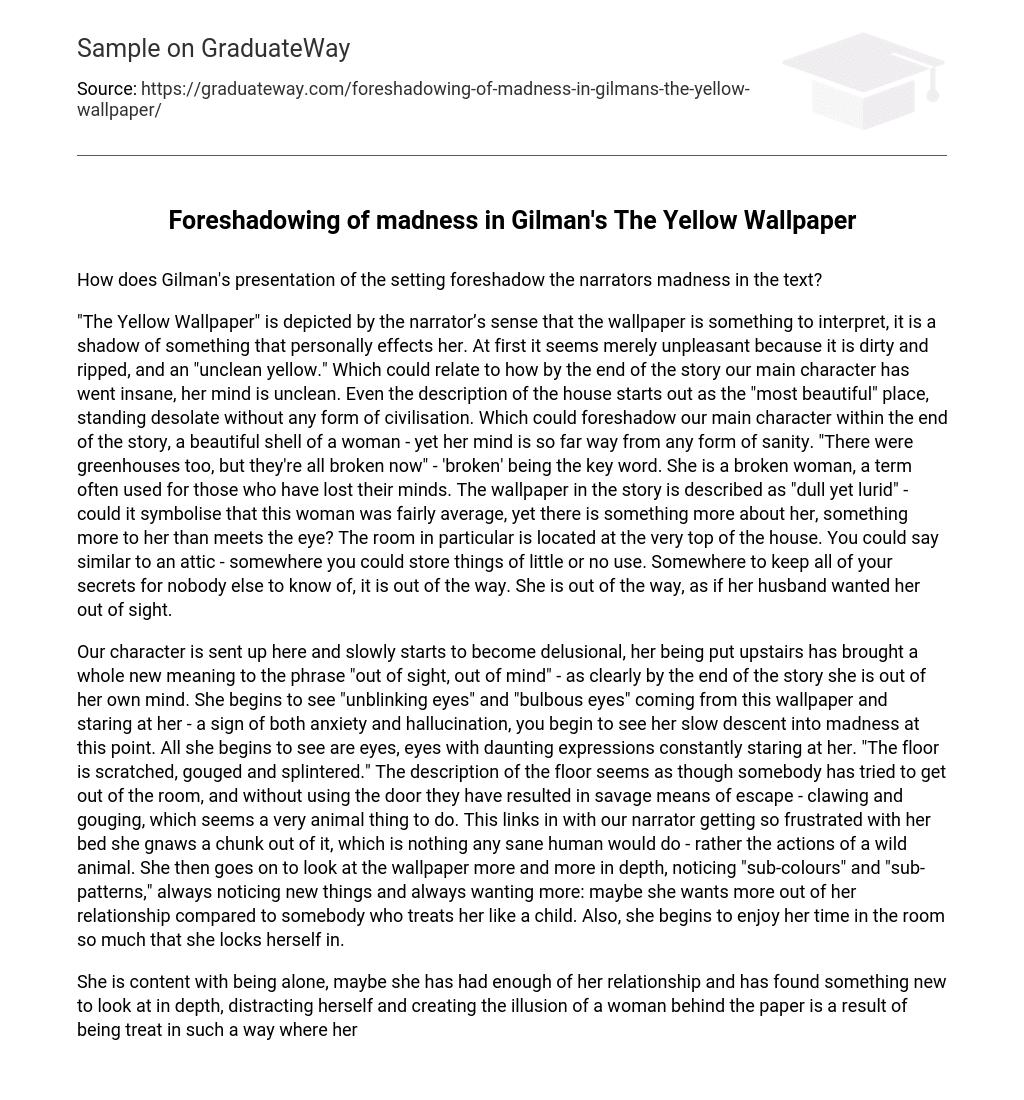How does Gilman’s presentation of the setting foreshadow the narrators madness in the text?
“The Yellow Wallpaper” is depicted by the narrator’s sense that the wallpaper is something to interpret, it is a shadow of something that personally effects her. At first it seems merely unpleasant because it is dirty and ripped, and an “unclean yellow.” Which could relate to how by the end of the story our main character has went insane, her mind is unclean. Even the description of the house starts out as the “most beautiful” place, standing desolate without any form of civilisation. Which could foreshadow our main character within the end of the story, a beautiful shell of a woman – yet her mind is so far way from any form of sanity. “There were greenhouses too, but they’re all broken now” – ‘broken’ being the key word. She is a broken woman, a term often used for those who have lost their minds. The wallpaper in the story is described as “dull yet lurid” – could it symbolise that this woman was fairly average, yet there is something more about her, something more to her than meets the eye? The room in particular is located at the very top of the house. You could say similar to an attic – somewhere you could store things of little or no use. Somewhere to keep all of your secrets for nobody else to know of, it is out of the way. She is out of the way, as if her husband wanted her out of sight.
Our character is sent up here and slowly starts to become delusional, her being put upstairs has brought a whole new meaning to the phrase “out of sight, out of mind” – as clearly by the end of the story she is out of her own mind. She begins to see “unblinking eyes” and “bulbous eyes” coming from this wallpaper and staring at her – a sign of both anxiety and hallucination, you begin to see her slow descent into madness at this point. All she begins to see are eyes, eyes with daunting expressions constantly staring at her. “The floor is scratched, gouged and splintered.” The description of the floor seems as though somebody has tried to get out of the room, and without using the door they have resulted in savage means of escape – clawing and gouging, which seems a very animal thing to do. This links in with our narrator getting so frustrated with her bed she gnaws a chunk out of it, which is nothing any sane human would do – rather the actions of a wild animal. She then goes on to look at the wallpaper more and more in depth, noticing “sub-colours” and “sub-patterns,” always noticing new things and always wanting more: maybe she wants more out of her relationship compared to somebody who treats her like a child. Also, she begins to enjoy her time in the room so much that she locks herself in.
She is content with being alone, maybe she has had enough of her relationship and has found something new to look at in depth, distracting herself and creating the illusion of a woman behind the paper is a result of being treat in such a way where her only objective is to stand there and look pretty (she even references her husband’s dislike towards her writing early on within the text.) Her description of the wallpaper gradually alters, as at first she seen “bulbous” eyes and the shades were “sickly” – she starts to grow fond of the room, and begins noting the paper’s “curves” and “flourishes.” The wallpaper begins to become a possession of hers, something only she can look at in such detail. “You think you have mastered it, but as you get well underway in following, it turns a back somersault and there you are. It slaps you in the face, knocks you down, and tramples on you. It is like a bad dream.” This sentence alone says so much, she is beginning to feel tortured by an inanimate object.
The wallpaper itself has not physically harmed her in any way, but is beginning to play on her mind, as if she is suffering because of the aesthetics the wallpaper possesses. Like a bad dream that she simply cannot escape from, the wallpaper is challenging – “you think you’ve mastered it,” there is personification of the wallpaper as if it is out to get her. Ultimately, the floral pattern has led to her insanity. Illusions of a woman within the patterns are noted whenever a different kind of light shines on it from the window, although the woman is not physically there – the narrator is making this up, again creating a distraction from the outside world. She will not exit the room until she has caught the woman when little does she know, it is all in her head. In the end we find that the woman within the wallpaper is actually the narrator, she has brought the insanity upon herself.





